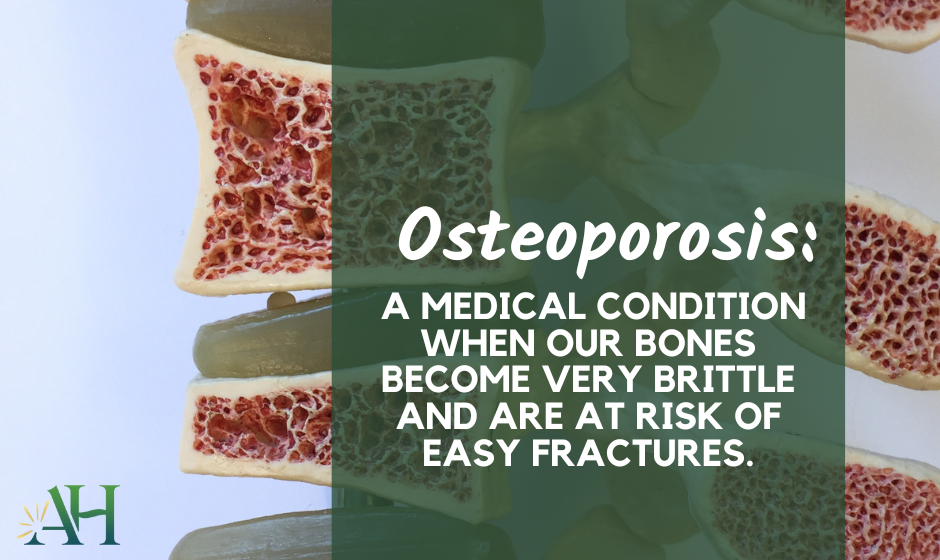Today I want to discuss the concept of bone health and touch on the medical problems associated with osteoporosis.
At our office, we strive to help patients maintain their health over a lifetime while avoiding preventable health conditions. This is a long-term view of health, doing things now in order to reap the benefits later. When it comes to our bones, this long-distance strategy is critically important.
Understanding our bones:
Despite what Halloween would have you believe, our bones are living objects, constantly going through remodeling cycles of building up and breaking down. It is also the main source of calcium and phosphorus for our bodies to use. During our childhood and adolescence, our bones are in accelerated state of growing and building strength. This makes sense — we are growing and developing and need our skeleton to keep up! But around our mid-twenties to early thirties, this building process plateaus and move into a more balanced phase of building up and breaking down. But as we age, we start seeing this breakdown process occurring at a more rapid pace than bone-building processes. Over time, this contributes to brittle bones, also known as osteopenia and osteoporosis.
What is osteoporosis?

To understand the solution, we must first know about the problem. Osteoporosis is a medical condition when our bones become very brittle and are at risk of easy fractures. Although osteoporosis can happen in both men and women, women are disproportionally affected due to menopause and having smaller relative frames. Other medical conditions also increase osteoporosis like diabetes, overuse of steroids, and having chronic autoimmune conditions like rheumatoid arthritis. The most difficult aspect of osteoporosis is that it is very difficult to reverse. We have medications that help slow down bone loss and some that may build bone somewhat, but nothing that remarkably improves bone quality.
What’s the problem with osteoporosis?
Having osteoporosis increases your risk of having bone fractures, especially of the hip. Many studies support that your risk of death within 1 year after a hip fracture ranges between 20% to 30%, making it the leading cause of injury-related death in adults over 65 years old. This is a staggering statistic and likely attributed to many factors: diminished physical activity, loss of muscle mass, worsening dementia (if already present), side effects of pain medication, etc. For many that make it past the 1-year mark, they are often unable to return to their previous level of functioning.
So how do I prevent osteoporosis?
 The first step in improving bone health and preventing osteoporosis is recognizing that we are all at risk — all of us will experience bone loss as we age. The best way to prevent this bone loss from becoming significant is to have stronger bones BEFORE we start seeing this decline. This is why we need to take a long-term approach to our bone health. There are a few strategies, if employed over years and decades, that will increase the chance that you will maintain strong, healthy bones for a lifetime.
The first step in improving bone health and preventing osteoporosis is recognizing that we are all at risk — all of us will experience bone loss as we age. The best way to prevent this bone loss from becoming significant is to have stronger bones BEFORE we start seeing this decline. This is why we need to take a long-term approach to our bone health. There are a few strategies, if employed over years and decades, that will increase the chance that you will maintain strong, healthy bones for a lifetime.
Resistance training. This is the MOST important factor when it comes to bone health. Lifting weights of both arms and legs will force our bones to turn on genes that lead to thicker, stronger bones. The amount of weight needed to do this varies for everyone, but you want to achieve a level of resistance that forces your body to work. This should be at least 30-60 minutes per week for best results.
Avoiding medications that can harm bones. This is mostly a recommendation against unnecessary oral/injection steroid prescriptions. If you have asthma, COPD, or autoimmune conditions, prednisone is an often unavoidable aspect of treatment. But for others, it would be wise to limit this exposure.
Maintain a very healthy diet. By fueling your body with nutrients, you are giving your bones the building blocks it needs to stay healthy. Plant-rich foods and dairy products that contain calcium are important. Lean meats or bone broth can help with increasing collagen peptide intake. Do not forget: getting enough calcium in your diet is FAR more important than taking a calcium supplement, which can have very limited absorption.
Maintain a healthy level of Vitamin D and minerals. To be clear, the data on Vitamin D is very mixed and controversial. But it is a fairly harmless supplement at lower doses. At a minimum, if you have low levels of Vitamin D, I would recommend supplementing with a high-quality Vitamin D to get this to proper levels. Your bones mineral support like calcium, magnesium, and Vitamin K, which you can get through food and/or supplementation. Please discuss with your doctor prior to starting any type of supplement, of course.
What if I already have osteoporosis?
If you have already developed osteoporosis (or told you have osteopenia), we need to adjust our strategy to keeping you from having a fall.
Everything listed above, especially strength training, is still very important. It may be difficult to build back bone but we can at least try to prevent further bone loss. This will also increase muscle mass, which is critical for keeping you upright! Doing supplements alone will not cut it.

You will need to strongly consider medications to help prevent further bone loss. I understand the concerns surrounding medications; but I’ve already highlighted the significant risk that comes with hip fractures. It is important to remember that the chance of side effects from these medications are much, much lower than serious risks after a fracture. Therefore for most, it’s almost always more risky to defer treatment once you have established osteoporosis.
I hope this was a helpful walkthrough on bone health and strategies you can start today to help keep your bones healthy and strong.










Thank you for this information, and challenge.